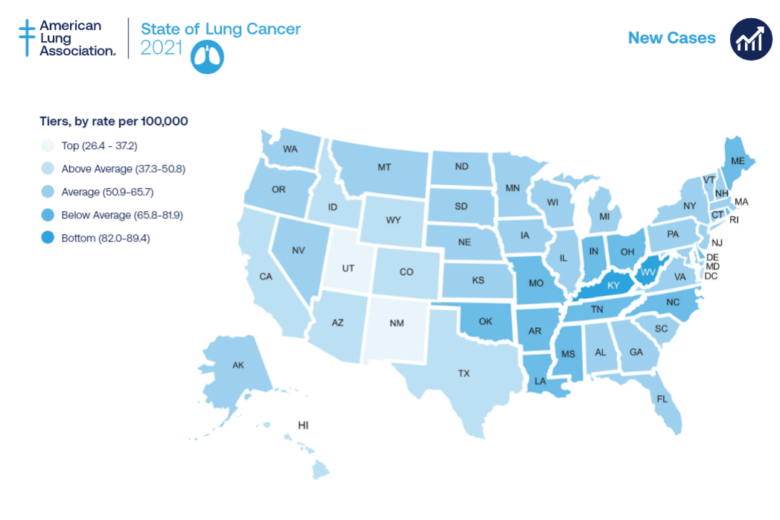People of color who are diagnosed with lung cancer face worse outcomes when compared to whites, according to the American Lung Association’s 2021 “State of Lung Cancer” report.
It notes dramatic disparities in D.C., while Virginia overall ranks above average for people receiving treatment and Maryland ranks among the best states in the nation for survival and treatment.
The national lung cancer survival rate is 20% for communities of color and 18% for Black Americans.
“We have improved with regards to survival with lung cancer over the last decade or so — we’re up to 23.7% five-year survival (overall), which is better, but again, not where it should be,” said Dr. Amit K. Mahajan, an American Lung Association volunteer medical expert.
Known as “Dr. Bobby,” Mahajan is medical director of Interventional Pulmonology and Complex Airways Disease Program at Inova Medical Group, which serves Northern Virginia and the D.C. area.
“All groups of individuals, whether it be by males, females, different backgrounds, in terms of Black Americans, Asian Americans, everyone, we should all be improving at the same pace,” he said. “And unfortunately, we’re seeing that black Americans especially are not having the same kind of survival, identification, and treatments, as we would hope, at this day in 2021.”

In DC:
- Black Americans, when compared with white Americans are 126% more likely to be diagnosed with lung cancer (59.5 of 100,000 vs. 26.3 of 100,000); 31% less likely to receive surgery; and 32% more likely to receive no treatment.
- Compared to other states, D.C. is among the worst in the nation for early stage diagnosis, lack of treatment and high-risk screenings for lung cancer.
- It’s seventh in the nation for the number of new cases of lung cancer at 45.4 per 100,000 compared to 57.7 per 100,000 nationally.
In Maryland:
- Maryland ranks among the best in the nation for lung cancer survival, surgical treatment rates, and cases receiving treatment.
- The state is ninth in the nation — among the best for treatment at 17.7% — for those receiving no treatment. An improvement over the 21.1% of cases nationally receiving no treatment.
- Latino Americans are 29% less likely to be diagnosed at an early stage, and Asian Americans and Pacific Islanders are 23% less likely, when the five year survival rate is much higher. Black Americans are 12% less likely than white Americans to receive surgery as a first course of treatment.
- It’s 18th in the nation for new cases of lung cancer at 55.4 per 100,000 compared to 57.7 per 100,000 nationwide.
In Virginia:
- Virginia ranks above average for people receiving treatment after diagnosis (8 of 49) but Black Americans are 8% less likely to be treated than white Americans.
- In Virginia, Asian Americans and Pacific Islanders are 23% less likely and Black Americans are 14% less likely than white Americans to be diagnosed early for lung cancer. Black Americans are also 18% less likely than white Americans to receive surgery as a first course of treatment; and 8% less likely to receive treatment after diagnosis.
- It’s 16th in the nation for new cases of lung cancer at 55.1 per 100,000 compared to 57.7 per 100,000 nationally.
Getting screened
The U.S. Preventive Services Task Force last March recommended screenings begin at age 50 instead of 55. This recommendation is for people with smoking exposure of 20 packs per year versus 30, which is the equivalent of smoking one pack a day for 20 years, or two packs a day for 10 years.
“Although Virginia and D.C. [are] in the middle of the averages for the country in terms of lung cancer screening (Maryland is also average), lung cancer screening as a whole is still very low. In all honesty, we look at anywhere from two to 12%, across the country, of Americans who qualify for lung cancer screening are actually getting lung cancer screening,” Mahajan said.
“And by performing lung cancer screening, we’re able identify cancers earlier and provide the ability to treat these patients and cure them. So really, what I would say is we’re improving, but we could be improving much more.”
“We need to identify this as a real national emergency — the number of patients who are dying of lung cancer and who are not getting appropriately screened. The idea of someone lacking breast cancer screening, colon cancer screening, having this many people die from it, and not having screened would be unheard of. Unfortunately, there is somewhat of a stigma when it comes to lung cancer, because the most common cause of lung cancer is smoking,” Mahajan said.
You can take the quiz to find out if you’re eligible for lung cancer screening at the American Lung Association’s website. It’s also recommended that you talk to your doctor about getting screened.








